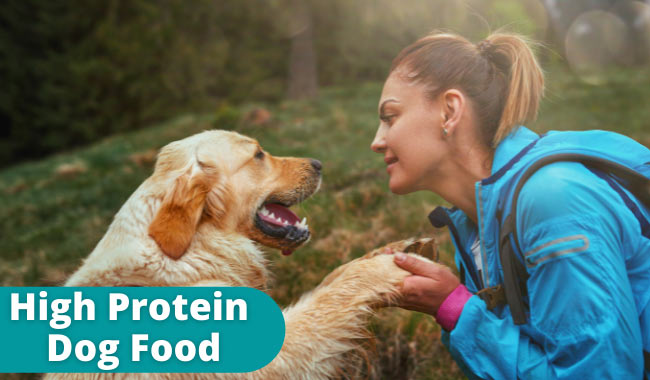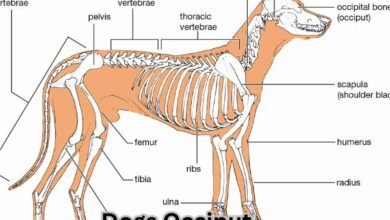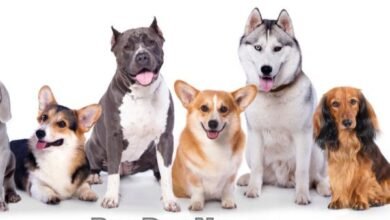
Does high protein dog food cause weight gain- Have you noticed recently that your dog’s ribs are starting to show, despite feeding them multiple meals a day? Sudden weight loss can be terribly worrying for any dog owner. There are many reasons why your dog may be losing weight, ranging from an injury to parasites.
Are you anxious to help get your dog back to normal but not sure where to start?
Don’t worry! We’ve prepared a complete guide to help you decide your next move so you can help your dog gain the weight back in no time.
Causes of Weight Loss in Dogs
Weight loss is often caused by an underlying health issue. If your dog exhibits rapid weight loss, you should visit a veterinarian immediately. Only after discovering the cause of the weight loss can you help your dog get back on track.
The cause of rapid weight loss could be due to:
- Pancreatic acinar atrophy
- Inflammatory bowel disease
- Diabetes
- Parasites in the digestive tract
- Surgery
- Hormonal disorders
- Anxiety
- Liver disease
- Dental infection
Resource:
https://www.petmd.com/dog/slideshows/7-causes-weight-loss-pets#slide-1
What do you do After the Diagnosis?
Once the vet has identified the problem and prescribed medication, you’ll need to wait until your dog has completely healed. After that, you can start weight gain training.
Do not try to feed your dog too much at once. Progress gradually and be patient. Dogs are creatures of habit. They don’t respond well to sudden, dramatic changes in their routine. You can end up making your dog sick if you move too quickly.
Keep a Journal to Document Weight Loss and Gain
A journal can be immensely helpful in tracking your dog’s weight gain. Record your dog’s weight regularly so you can determine whether the training regime is working. If not, you can always make a change. If there are no improvements or you fear your dog is getting worse, go back to the vet for a second opinion.
You can also track feeding times and the type of food your dog responds well to. Keeping a note of this is especially helpful if your dog is a fussy eater. Write down the quantity and nutritional information about the food your dog consumes.
For ease of use, keep the journal near your dog’s feeding spot.
Determine the Healthiest Weight for your Dog
You can ask the vet to perform a test called body conditioning scoring (BCS) to determine whether your dog is skinny, overweight, or the ideal weight. If the results show that your dog is too thin, then ask your doctor to help you design a weight gain program. He should be able to tell you the goal weight you should be striving for.
You can also tell if your dog is the right size by a visual examination. If you look at your dog from above, their waist should be visible. By touching the sides, you should be able to feel the ribs but not see them. Finally, your dog’s abdomen should curve inwards all the way to the hips.
Your dog is underweight if the ribs, hip bones, and backbone are too conspicuous. However, keep in mind that hunting dog breeds (Greyhounds, Border Collies, Pointers, etc.) are typically thinner than their bulkier counterparts (Mastiffs and Labrador Retrievers).
Check for Parasites
Parasites such as the tapeworm infect the intestinal lining and absorb nutrients from food, therefore depriving your dog. As a consequence, they lose weight and fall ill. If the vet suspects tapeworms, they will test your dog’s feces and prescribe medicine accordingly. Also, don’t forget to check for fleas and other mites.
Maintain a Proper Exercise Routine for your Dog
A healthy dog possesses more fat than muscle. Exercise is essential for building muscle. Overall, exercise helps to keep your dog in shape. If your dog is aging or suffering from an illness that causes muscle wasting, ask the vet for a special exercise routine to make sure you don’t overwhelm your dog.
Light exercise such as leash walking or swimming will not cause overexertion. You can even adjust how rigorous the workout is by increasing the time and distance walked.
Things to Do Before Weight Training
For the best results, you’ll need to come up with a plan. Having a plan will help you go about weight training effectively. You won’t have to go through the trouble of deciding when and how much you should feed your dog every day. Answering the following questions will aid you in building the perfect weight gain regime.
1. Organize a Timetable for Meal Times
According to research, eating before bed may lead to weight gain. This applies to both dogs and humans. Dog owners can take advantage of this and feed their pets two meals a day; a small meal in the mornings and a larger meal at night. Feeding a larger portion at night means that your dog will not run off the calories, and instead, they can be converted into fat.
Another way for designing an effective routine for mealtimes is splitting meals into three or four parts and feeding your pet throughout the day. Thin dogs who have a harder time keeping down two large meals can benefit from this regime. You can even add meals to increase the calories.
Make sure to wait 30 minutes after every meal before you exercise your dog to prevent bloating. Changing up the current feeding routine of your dog will affect their bathroom habits, so you may need to reschedule walks.
2. What to Look for in the Foods you Give your Dog
You could give your dog huge bowls of food, but if it’s not the right quality, it won’t do much good. Underweight dogs require a diet containing moderate amounts of protein and fat. They should also be getting enough carbohydrates. Any dry food you purchase should have 18% fat and between 28% to 30% protein.
In fact, you should get into the habit of religiously checking the food nutrition labels at the back of the package. The primary protein source in your dog food should be beef, chicken, turkey, etc., instead of carbohydrates such as corn or wheat.
Stay away from foods that contain fillers like meat meal, corn syrup, and white flour. These don’t add any nutritional value. Although dog food with healthier recipes will cost you more, they’ll at least give you the desired results.
Additionally, ask your vet for their recommendation on the number of calories your dog should be consuming daily.
3. The Recommended Quantity that Should be Fed
Stretch receptors in the stomach are responsible for the coordination of muscle activities. When a dog is deprived of food or used to eating less, they feel sated sooner because of these stretch receptors. That’s why feeding them too much too soon can cause discomfort or even vomiting.
In severely underweight dogs, overfeeding can be risky and have dangerous repercussions like refeeding syndrome. This is a deadly condition where there is a decline in phosphorus, potassium, and magnesium levels in the body. It results in lethargic muscles, cardiac irregularity, nausea, diarrhea, and seizures. Therefore, gradually increasing your dog’s portion sizes so they have time to adjust reduces the chances of this happening.
To avoid this condition, start by calculating the resting energy requirement (RER) of your dog. This can be done by using the following formula:
“Resting Energy Requirement (in Kcals/ day) = (Your dog’s weight in kilograms x 30) + 70”
For the first day, feed only 25% of the RER to your dog. Increase this by 25% every day until you can feed your dog the full amount of RER. Once the risk for the condition has been avoided, you can begin weight training to help your dog gain weight.
Health Benefits of High Protein Dog Food
A diet full of protein can have the following positive impacts on your pup:
- Growth of lean muscle
- Strengthening of the immune system
- Healthy skin and a shinier coat
- Prevention of muscle atrophy in older dogs
Keep in mind that active dogs need more protein in their diet for energy; otherwise, their body will start to break down muscle protein.
How to Help Your Dog Gain Weight
Now you know how to go about weight training your dog. But there’s still one question that remains unanswered. What do I feed my dog to help them gain weight?
You can go about this in two ways: feeding them home-cooked meals or canned food. The former is an excellent choice if done right. There are many recipes on the internet that your dog may like. Remember to get vet approval before you try any recipe.
Although canned dog food is processed and comparatively less healthy, there are still many great dog food manufacturers that sell healthy recipes. If you find yourself short of time to do much cooking, opt for the latter.
The following will help your dog to gain weight:
1. A High Protein and Fat Diet
Protein and fat are essential for your dog’s growth and to sustain its energy reserves. Switching to foods that contain higher percentages of these two ingredients will help your dog to gain weight. If you find the dog food that contains a higher protein content and the same meat source as the current food your dog enjoys, you can immediately start feeding it to your dog.
However, if the meat sources differ, then you should switch this over gradually. Start with 90% of your current dog food and 10% of the new dog food, then mix 80% of your current dog food with 20% of the old dog food. Keep doing this until 100% of the dog food has been replaced by the new food. This whole adjustment process takes 10 to 14 days. Your dog may suffer from digestive problems for a while as a result.
To help your dog limit their fat intake as this can upset their stomach.
2. Pumpkin and Sweet Potatoes: Superfoods for Weight Gain
Feeding your dog too much meat protein may have adverse effects on their health. It was also expensive. Instead, look into swapping meat for some veggies. Pumpkin and sweet potatoes are great for your dog’s health and your wallet. They are marvelous vegetables that will really help your dog gain weight. Rich in fat and fiber, pumpkin is great for packing on the pounds, while sweet potatoes prevent digestive problems from an excessive fat intake.
Purchase canned versions of these vegetables. Contrary to popular belief, canned foods are nutritionally equivalent to fresh vegetables and may even be superior. Also, Keep an eye out for any digestive issues in your dog.
3. High-Fat Foods with a Side Serving of Vegetables
Give your dog a special treat of organic carrots covered in peanut butter. Peanut butter is a canine favorite and is high in fat. Pairing this with a high fiber, low sugar, and low acidity vegetable like a carrot will balance any stomach issues. Your dog will now have smoother bowel movements and gain weight. That’s hitting two birds with one stone!
Do not try feeding your dog fruit with peanut butter, as this may cause digestive problems. Fruits have greater acidity. Ensure that the peanut butter you feed your dog is organic and has no added salt, sugar, or xylitol.
4. Give your Dog Puppy Food
Growing puppies require more calories which is why puppy food has a greater caloric value. Feeding puppy food to your dog can help them gain weight.
5. Mix Dog and Human Foods
For dogs who don’t have much of an appetite, entice them to eat by topping their food with tasty human food. Certain human foods are highly palatable to dogs and can even be healthy for them. You can use a couple of teaspoons of vegetable, chicken, or beef broth as toppers. Look for no-salt options at the supermarket.
Other options to feed your dog include soup from canned tuna, non-fat cottage cheese, and non-fat plain yogurt. Never give your dog chocolate, raisins, grapes, onions, garlic, or any moldy food. These can be fatal to dogs.
6. Moisten Dry Food with Water to Make it More Appealing
All dogs are different. Some, unfortunately, turn out to be fussy eaters, which makes weight training a challenge. Nevertheless, you can use certain tactics to lure your dog into eating. While many dogs may not be particularly fond of dry food, it’s important to note that dry food often has better nutritional value than wet food.
So, how do you get your dog to eat more dry food?
Moisten the dry food with warm water or a strong, aromatic chicken broth to tempt your dog. This will give dry food a semi-liquid texture that makes it easier to swallow. If your dog is resistant to all these methods, switch to making homemade meals. Ask your vet for recommendations on where you can find reliable recipes to aid in weight gain.
7. Try Giving your Dog Supplements
Your dog may be lacking certain vitamins and minerals, especially if they are underweight. You can compensate for this by adding broad spectrum vitamin and mineral supplements to their daily meals. Fatty acids such as Omega 3 and Omega 6 are essential for maintaining good canine health. These are not created within the body and must be derived from food or food supplements.
Conclusion
Sudden weight loss in your beloved canine companion can be frightening for any owner. It could point to an underlying health issue. Nevertheless, with a veterinarian’s help and proper care, your dog can be restored to good health. Always be consistent with meal times and all aspects of your dog’s weight training regime.
Remember, it will take time to see results. Don’t be disheartened. Keep going, and be sure to give your dog plenty of love and affection along the way.



